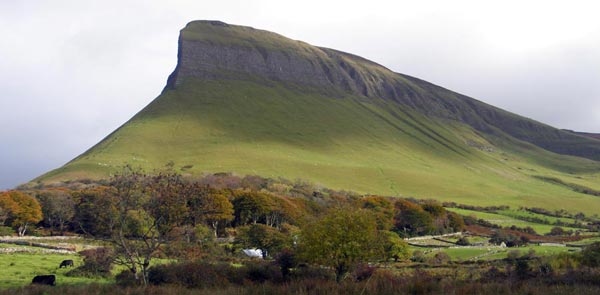The Scholar Who Went with the Fairies October 5, 2017
Author: Beach Combing | in : Contemporary, Modern , trackbackPeter Alderson Smith is an English scholar who in 1987 wrote a really very good book on Irish fairies: W. B. Yeats and the Tribes of Danu. In the middle of the book there is one of these passages where you think: what?!? Beach to help inattentive readers has italicized the relevant clause. Note that the very serious Smith is writing about the fascinating overlap between earth lights and fairies.
At night, particularly in November, lights often travel along these paths and hover over the sidhe [fairy mounds]. They sometimes move in formation. They may be all white, or they may be of different colours – ‘red, green, blue, yellow.’ A very old gentleman from Collrai, Co. Sligo…. tells me that the lights move rapidly, and I have myself seen white lights moving at high speed up the side of Ben Bulben, a mountain renowned for this phenomenon. These lights have been known in Ireland since antiquity. In ‘The Colloquy with the Ancients’ Bodh Derg refers to Brugh na Boinne as ‘yonder brugh chequered with the many lights hard by you here.’ Such lights are not confined to marshy ground and so cannot be will o’ the wisps. They are genuine phenomena, but no scientific explanation has been found for them.’
Do you see how Peter tried to slip that fairy sighting unobtrusively into his five star academic book? Ben Bulben is the fabulous mountain at the head of the post: Beach would dearly like, one day, to see fairy lights there. Can anyone help: drbeachcombing At yahoo DOT com
PS W. B. Yeats and the Tribes of Danu might sound to the casual outsider (Beach three weeks ago) like a bit of esotericism about one of the better English-speaking poets of the last two centuries. But the book is rather more than this. The third part is about Yeats, but the first and second parts have wider applications. Part one looks at medieval sources for Irish fairies: part two is concerned with modern Irish fairylore. If you can get it…
31 Oct 2017, Bruce T writes: Beach, that’s a little phenomena that occurs on bare rock “balds” or “knobs” in the Appalachians from Central WV to Georgia. Here it’s called “Fire on The Mountain” by some and “Spook Lights” by others. the most regular and well known being the Brown Mountain Lights in North Carolina. There’s a long history/mythology/folklore about the phenomena among the Native Americans who used to inhabit the region, the lights being attributed sometimes to man-eating “Thunderbird” like beings due to all the bones scattered around the balds. A stone “bald” is very dangerous place to be in lightning season as any animal is the tallest thing on it and the closest thing to an electrical “ground”. A few hikers a year are killed on balds in the Appalachians by lightning when a storm suddenly comes up, which they regularly do. The stories about the lights themselves go back to pre-European times in many places, especially in N.C. where the Eastern Cherokee still remain. It’s thought to be related to the geology of the some of the balds themselves. Under certain conditions you get “ball lightning” on and around the peaks, especially the granite and limestone ones. The area where phenomena is most reported is along the higher ridges in the range where cooler drier air from the interior meets the warmer wetter air from Atlantic and Gulf of Mexico. Ben Bulben is a limestone bald located between the warmer Atlantic and the cooler waters of the N. Irish Sea and the interior. Similar circumstances and similar “spook lights” in both places. Add in the fact that the area of the spook light balds in the the S.E. US are in areas heavily settled by the Ulster Irish and you’ve got the right stew for a transference of European folklore melding with previously existing Native American folklore that lasts to the present day here. People have been trying to explain the Brown Mt. Lights away for years, but they have a very odd feature, they disappear for years, then show up again regularly, and then go away again, only for the pattern to repeat. They showed back up a year or so ago after a few years of not being seen. Just when they’re solved, they throw researchers a curve ball. The region where the lights mainly occur is also where a large chunk of the African plate collided with the East Coast of N. America millions of years ago causing parts of the already existing Appalachians to experience upthrust while the ranges nearer to the collision were overshot by the section of the African Plate. I suspect it’s related to the phenomena here, but I have no concrete evidence? However the African plate did cover an ancient volcanic hot spot that is responsible for the warm and hot springs that dot the same region as the balds. Earth lights? St. Elmo’s Fire? Emerging small methane seeps ignited by occasional lightning seen only in low light? Who knows? But they perplex the Hell out of the people who research them and that’s what makes them fun.



